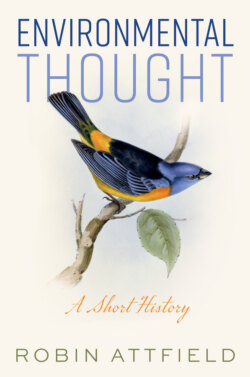Читать книгу Environmental Thought - Robin Attfield - Страница 18
The New Testament and the Christian message
ОглавлениеThe New Testament was written over roughly a century, mostly in the eastern Mediterranean, but partly in Rome. Despite their differences of emphasis, its writers largely assumed the overall message of the Old Testament; but as they were concerned to express the Christian message to non-Jews, including their belief in God as creator, they conveyed this message in distinctive ways, seeking to explain and summarize for Gentiles what the Jews had learned gradually over a long period.
Thus Paul suggests that many of these people had failed to see God’s works in nature, clear as they were: ‘Ever since the creation of the world his invisible nature, namely his eternal power and deity, have been clearly perceived in the things that have been made’ (Romans 1:20). Likewise in Acts, Paul and Barnabas affirm that, even in past generations, ‘he did not leave himself without witnesses, for he did good and gave you from heaven rains and fruitful seasons, satisfying your hearts with food and gladness’ (Acts 14:17; Glacken 1967: 161). These passages were later used to supply arguments for God’s existence based on nature and its order.
Jesus too assumed God’s existence and care, but used common experience to express this. ‘Consider the lilies of the field, how they grow … And yet I say unto you that even Solomon in all his glory was not arrayed like one of these’ (Matthew 6:28–29). The ‘fowls of the air’ are treated similarly in the same passage, with the rider that people are more valuable than they are (Matthew 6:26). But even this rider presupposes that the birds and the flowers have an independent value of their own, a stance nowadays known as ‘biocentrism’, which is compatible with the belief that people, with their ampler capacities, are of greater value. (Biocentrism need not imply that all creatures are of like value. For an elucidation of biocentrism, see Chapter 2.)
Problem passages from the gospels, about Jesus sending the Gadarene swine to their deaths (Mark 5:11–14) and cursing a barren fig-tree (Mark 11:12–14), were taken by Augustine to indicate that refraining from killing animals and destroying trees is ‘the height of superstition’ (Passmore 1974: 111–12). But this passage tells us far more about Augustine and his polemical powers (directed against contemporary opponents) than about Jesus. Stephen Clark suggests that the narrative about the Gadarene swine may have originated in a parable, rather than as a historical event (1977: 196), while Luke 13:6–9 records a parable that could easily have been transformed into the story about the cursing of the fig-trees in Mark. (For other examples of New Testament narratives probably originating in parables, see Attfield 1991 [1983]: 30.) These problem passages, then, need not constitute obstacles to Jesus holding the biocentric attitudes shown in the passage about the birds of the air and the lilies of the field (Matthew 6:26–29), and suggested also by his consorting with the wild beasts in the wilderness (Mark 1:13), which is an echo of the behaviour associated in the Old Testament with the Messiah. (Biocentrism is discussed in greater detail in the next chapter.)
Paul, for his part, was clear that the whole of creation was involved in God’s plan of salvation, ‘groaning in travail’ and yearning for its fulfilment (Romans 8:19–22). And the author of Revelation foresees that in the last days there will be a tree of life, the leaves of which ‘are for the healing of the nations’ (Revelation 22:2). Glacken (1967: 163) regards the passage of Romans just mentioned as far more representative of Paul’s thinking than passages later interpreted as concerning sin being inherited from Adam, the first human. The Bible, then, regards nature as both God’s creation and as being involved in his plan for redemption.
Lynn White (1967) has claimed that Christianity is ‘the most anthropocentric religion the world has seen’. ‘Anthropocentrism’ is variously used to mean either the view that everything exists for the sake of human interests (teleological anthropocentrism), or the view that the criterion of moral rightness is fostering human interests alone (normative anthropocentrism). White may intend both of these, but qualifies his claim with ‘in its Western form’, thus referring in the first instance to two millennia of Christianity in the West. However, it is appropriate to remark at this stage that, despite occasional anthropocentric biblical passages (e.g., Paul’s stance on oxen at 1 Corinthians 9:9), the Old Testament is clearly incompatible with anthropocentrism in both of these senses (see Psalm 104, Proverbs 12:10 and Job 38–41), and that the overall message of the New Testament is, in this regard, no different. I will, however, return to White’s claims in the section below on the Middle Ages, to which they most directly refer.
